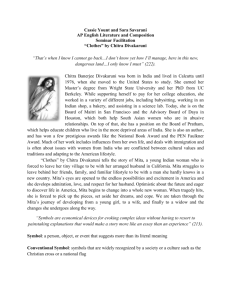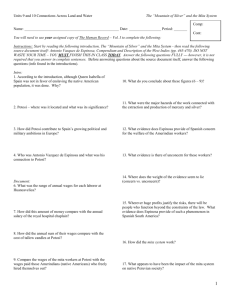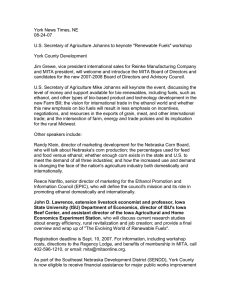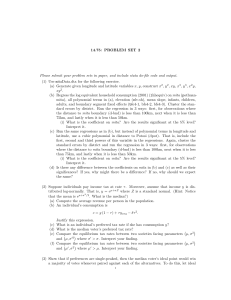Barry Glasgow and Alan Mandell Metropolitan
advertisement
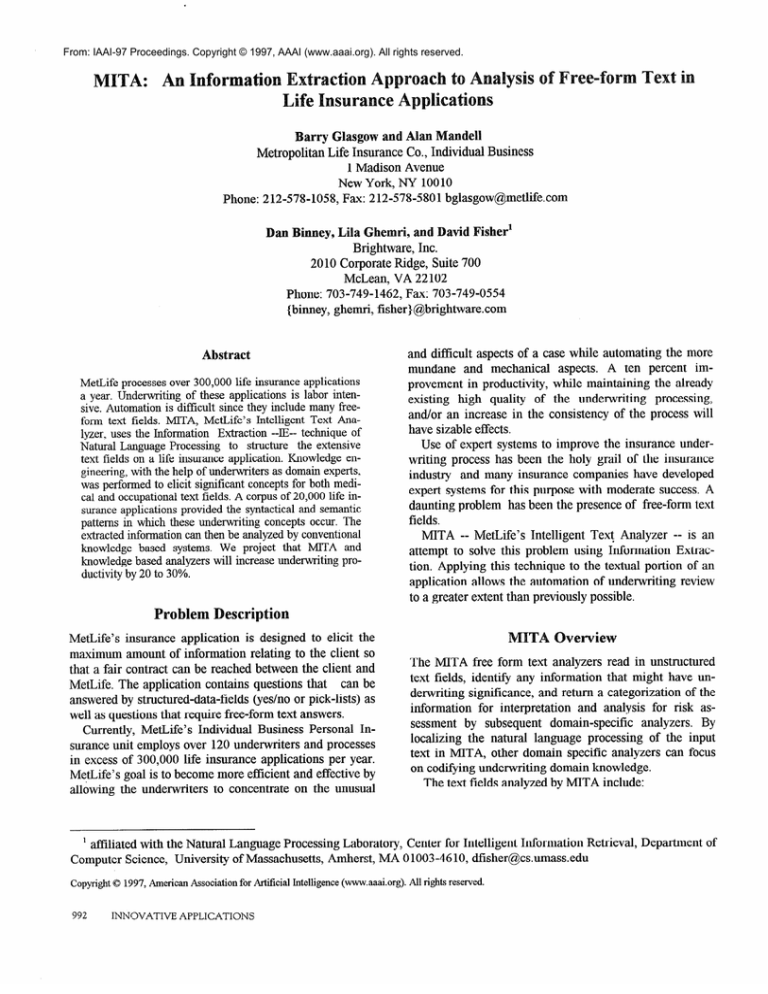
From: IAAI-97 Proceedings. Copyright © 1997, AAAI (www.aaai.org). All rights reserved.
Barry Glasgow and Alan Mandell
Metropolitan Life Insurance Co., Individual Business
1 Madison Avenue
New York, NY 10010
Phone: 212-578-1058, Fax: 212-578-5801 bglasgow@metlife.com
Dan Binney, Lila Ghemri, and David Fisher’
Brightware, Inc.
2010 Corporate Ridge, Suite 700
McLean, VA 22102
Phone: 703-749-1462, Fax: 703-749-0554
(binney, ghemri, fisher)@brightware.com
Abstract
MetLife processes over 300,000 life insurance applications
a year. Underwriting
of these applications is labor intensive. Automation is difficult since they include many freeform text fields. MITA, MetLife’s Intelligent Text Analyzer, uses the Information
Extraction --IE-- technique of
Natural Language Processing
to structure the extensive
text fields on a life insurance application. Knowledge engineering, with the help of underwriters as domain experts,
was performed to elicit significant concepts for both medical and occupational text fields. A corpus of 20,000 life insurance applications provided the syntactical and semantic
patterns in which these underwriting concepts occur. The
extracted information can then be analyzed by conventional
knowledge based systems. We project that MlTA and
knowledge based analyzers will increase underwriting productivity by 20 to 30%.
and difficult aspects of a case while automating the more
mundane
and mechanical
aspects. A ten percent improvement in productivity, while maintaining
the already
existing high quality of the underwriting
processing,
and/or an increase in the consistency of the process will
have sizable effects.
Use of expert systems to improve the insurance underwriting process has been the holy grail of the insurance
industry and many insurance companies have developed
expert systems for this purpose with moderate success. A
daunting problem has been the presence of free-form text
fields.
MITA -- MetLife’s Intelligent Text Analyzer -- is an
attempt to solve this problem using Information
Extraction. Applying this technique to the textual portion of an
application allows the automation of underwriting
review
to a greater extent than previously possible.
Problem Description
MetLife’s insurance application is designed to elicit the
maximum amount of information relating to the client so
that a fair contract can be reached between the client and
can be
MetLife. The application contains questions that
answered by structured-data-fields
(yes/no or pick-lists) as
well as questions that require free-form text answers.
Currently, MetLife’s Individual Business Personal Insurance unit employs over 120 underwriters and processes
in excess of 300,000 life insurance applications per year.
MetLife’s goal is to become more efficient and effective by
allowing the underwriters
to concentrate on the unusual
vewiew
The MITA free form text analyzers read in unstructured
text fields, identify any information that might have underwriting significance, and return a categorization of the
information
for interpretation
and analysis for risk assessment by subsequent
domain-specific
analyzers. By
localizing the natural language processing of the input
text in MlTA, other domain specific analyzers can focus
on codifying underwriting domain knowledge.
The text fields analyzed by MlTA include:
’ affiliated with the Natural Language Processing Laboratory, Center for Intelligent Information
Computer Science, University of Massachusetts, Amherst, MA 0 1003-46 10, dfisher@cs.umass.edu
Copyright 0 1997, American Association for Artificial Intelligence(www.aaai.org). All rights reserved.
992
INNOVATIVE APPLICATIONS
Retrieval,
Department
of
e
@
0
e
e
a Physician Reason field that describes the reason a
proposed-insured
last visited a personal physician
a Family History field that describes a proposedinsured’s family medical history
a Major Treatments and Exams field that describes
any major medical event within the last five years
a Not Revealed field that includes any important
medical information not provided in other questions
il~l Occupation Title and Duty field that describes the
proposed-insured’s
employment
AI in MITA
The Information Extraction@)
approach of Natural Language processing was chosen for use in MITA. The system
was engineered based on a corpus of actual application
texts. This approach was intended to provide a IE system
optimized for MetLife’s insurance application text processing needs.
Information
Extraction
Analysis of free-form text has been pursued mainly from
three viewpoints:
e
a keyword approach
e
an in-depth natural language analysis approach
e
an Information Extraction approach
The keyword approach,
whereby the input text is
scanned for words that are deemed highly relevant to the
application at hand, has the advantage of being relatively
easy to implement. However, it is of limited usefulness for
accurate data extraction, which is a requirement of MITA.
An in-depth natural language
analysis approach in
which the input text is fully and completely analyzed, is
usually highly complex, costly and relatively brittle. Furthermore it does not answer the need of an application in
which the interest is focused on some parts of the text, but
not necessarily all.
Information
Extraction
[Cowie and Lehnert,
1996;
Lehnert and Sundheim, 19911 is an ongoing area of natural language research, where the focus is on real working
systems with periodic performance evaluations. IE makes
use of Natural Language Processing (NLP) tools, (parsing,
tagging, dictionaries), but also uses knowledge engineering or machine learning to identify the concepts contained
in the texts and to form a framework of these concepts. In
this approach, the input text is skimmed for specific information relevant to the particular application.
To illustrate why IE provides a good match to the
problem, consider
the text field that describes
why the
client has last seen a physician. Frequently this field describes a visit for a ‘checkup’ with additional modifiers for
a specific disease, a chronic condition, or to fulfill an occupation or athletic need. A simple keyword search find-
ing ‘checkup’ would not provide suflicient information.
Alternately, full natural language processing with deep
semantics is not required because most Physician Reason
texts could be analyzed in terms of four concepts:
Reason, which usually describes the type of visit such
as “regular visit”, “school checkup”, or “post-partum
checkup”
8
Procedure/Treatment,
which describes a procedure or
a treatment such as “prescribed antibiotics”, “ear wax
removed’, or “HIV test”
e
Result, which describes the outcome of the exam or
the procedure such as “nothing found’, “all ok”, or
“no treatment”
e
Condition which describes a medical condition that
the applicant has such as “high blood pressure”, “ear
infection”, or “broken leg”
In building MITA, knowledge engineering was used to
create a representation
of the domain to be analyzed in
terms of important concepts. NLP techniques were used to
process text and to extract these concepts when they are
present in the text.
Recent advances in Information
Extraction from text
have been well-documented
in a series of rigorous performance evaluations
sponsored by DARPA called the
Message
Understanding
Conferences
(MUC)
[MUC-
%5,61.
A variety of techniques
have been tested at MUCs,
ranging from full-sentence
syntactic parsers to machine
learning algorithms. The majority of the systems tested
such as CIRCUS (Lehnert 1990), BADGER (Soderland
et. al. 1995) use robust partial parsing followed by pattern
matching to achieve information
extraction. MITA’s design was based primarily on the approach of BADGER.
escription
of the Corpus
The corpus used for this application contains some 20,000
applications, each with at least one free form text field. A
basic analysis of the sample was performed to determine
the range of syntactic forms commonly used. It was found
that most sentences were cryptic, and major syntactic constituents such as subjects and verbs were freely omitted.
Punctuation was terse and often incorrect. The text was
basically a series of noun-phrases
clumped together as in:
‘%-section childbirth 1979 no complications”.
The MITA system was built in three phases, an analysis
phase, a design and prototyping phase, and an implementation phase.
EMERGING APPLICATIONS
993
Initial Analysis
,
During the Spring of 1996, a team composed of MetLife
underwriters
and business analysts and Brightware consultants conducted an analysis of the free-form text fields
in MetLife’s New Business life insurance applications.
The goal was to determine the best way to handle these
fields in automating the underwriting
initial review process. Factors considered in this analysis of each field included
a
the nature and strategy of the question
a
the potential underwriting
significance and use of the
information
*
the syntactic and semantic structure of the text.
The resulting recommendations
for each field fell into
two categories:
0
conversion of the free-form questions into structured
questions(such as check-boxes and drop-down lists)
e
the development of intelligent text analyzers to process the free-form text and convert it into a form that
can be used by downstream analyzers
The results also included a list of the categories of potentially significant underwriting
information provided by
each field. These categories were called concepts. For example, for the Occupation analyzer three concepts were
found to be of significance : the job title as in “waiter”, the
description of the duties as in “serves food and beverages”
and the work environment as in “restaurant“.
Design ad
Prototype
During the second phase of the project, a general system
design was developed, along with a prototype system.
The prototype was based on the Physician Reason field.
Physician Reason was chosen because it is a field that is
populated on 75% of insurance applications.
It also presented a challenge since the medical terminology used was
fairly complex.
The prototype and design were developed by three
Brightware consultants
over a one-month period. Small
lexical and medical dictionaries were built as part of the
prototype.
Implementation
Based on the success of the prototype, an implementation
phase was begun. Text analyzers were to be built for four
Medical fields and one Occupational field.
The core project team consisted of seven Brightware
consultants working closely with four underwriters.
Each
underwriter represented expertise from a different area of
life insurance underwriting.
A number of MetLife system
engineers participated in the project as well.
Implementation
began in late August 1996 and the
completed system was released to system test in January
1997. At the time of this writing MITA is scheduled to be
deployed into production in the second quarter of 1997.
The diagram
MITA.
below
shows
the
major
INNOVATIVE APPLICATIONS
of
Figure 1. Overview of MITA’s Process
A freeform text field is first processed by the Parser
which tags the text syntactically and semantically.
Next,
the Extractor compares the parsed and tagged text to
known extraction patterns. When a pattern applies, the
extractor extracts important words and their classifications and categorizes them into what are called the text’s
concepts.
System Inputs and Outputs
The primary input to MITA is freeform text. An ungrammatical but typical example from a Medical field is the
string “after childbirth applicant suffers from iron defyciency medication “.
The exact output of MlTA is specific to the particular
field, but all analyzer outputs follow the same general
format:
e
Concept - a particular type of information that can be
found in this field
0 Value - the actual word(s) in the text which are associated with this particular instance of the concept
e
Class - the semantic class that the value denotes. Semantic classes are inferred from the ontologies
The output for this example would be:
Class
Concept
Value
‘%hildbirth ”
PARTURITION-NOS2
Condition
‘iron deflIRON-DEFICIENCYCondition
ciencv”
NOS
2 The NOS suffix means “not otherwise
994
components
specified’
Procedure/
Treatment
‘medication
”
handle during formal parsing. Some examples of nonstandard text normalized are abbreviations,
contractions, and
time periods.
DRUG-NOS
Figure 2. A sample output frame
MITA accomplishes its work through three major modules, including a parser, a set of extraction rules, and a set
of dictionaries.
The Parsing Module. The Parser first tags each incoming
word with a semantic classification,
and with a part-ofspeech. It then uses syntactic knowledge to segment the
text into noun phrases, prepositional
phrases, and verb
phrases. These constituents are then grouped together into
larger text fragments and assigned the clausal roles of
subject, verb, direct object, and prepositional phrase.
The Extraction
odule. Extraction rules are then applied
to
I. determine the presence of a given concept in the input
text being processed, and
2. fill out slots for the value and the class of concept
found.
Each extraction rule is an if-then rule which uses the
pattern matching mechanism
of ART*Enterprise@.
The
left hand side of the rule describes a set of constraints on
words and word senses found in the syntactic buffers of
the parser output. If these constraints are met, specified
roles are filled by asserting the facts from the right hand
side (the -then part-). A single sentence can generate an
arbitrary number of concepts depending on the complexity of the sentence being processed
elll Correction Module. The Spell Correction Module
uses a dictionary of common misspellings to correct misspelled words in the input. This dictionary was custombuilt for MITA and is composed of the words that were
commonly misspelled in the corpus.
odule. The Multi-word
Lookup
u&i-word Lookup
Module consists of a set of rules that look for typical word
patterns that should be handled as a single term. An example in the medical domain is the phrase “high blood
pressure”.
site Classifier. While Multi-word Lookup handles
at the word level, the composite classifier handles
them at the class level. This is useful for phrases that hold
their useful meaning at a more abstract level.
is defined as a composite
For example, “tonsillectomy”
class in MITA’s ontology. It has participant classes of
“tonsils-nosy’ and “excision-nos”.
When the text being
analyzed is “had tonsils removed’, an extraction rule produces the sequence {“tonsils-nos”
“removal-nos”
> as a
The
composite
classifier
recognizes
classification.
“removal-nos” as a child of the participant class “excisionnos”, and thus composes this sequence into the class
“tonsillectomy”.
to
ence Factor. MITA achieves a high level of performance because it does its best work on the most common texts. However, in the life insurance business, a
misinterpretation
of text, although rare, can be very costly
to the insurer.
MITA achieves its reliability, not because it analyzes
text perfectly, but because it can determine when it has
done well, and when it has not done well. This prediction
of extraction quality is accomplished through Confidence
Factors.
The Confidence Factor is derived primarily from the
types of words that were not extracted from a text. Unextracted words are given penalties based on part-of-speech,
and semantic class. Penalties also occur when a spelling
correction was performed or when a composite classification was attempted but was unsuccessful.
The higher the confidence factor, the more trustworthy
the output. Downstream analyzers decide whether a particular output is reliable to process automatically based on
the Confidence Factor. Each field has its own unique confidence factor threshold and its own set of penalty values.
ecoguizers. The Recognizers find and normalize nonstandard text contained in the input to make it easier to
Lexical Coder. Each class within MITA’s ontology has a
code which is used in subsequent automated underwriting
steps. This module lists out the hierarchical path of stan-
ictionaries. MITA relies on several dictionaries. It uses
a lexical dictionary containing words in their various inflected forms along with their parts of speech. It also uses
a description(ontoZo&
of the medical and occupational
domain in terms of a hierarchy of classes.
The lexical dictionary has connections to the classifications in the two other ontology dictionaries so that words
can be associated with semantic classes.
MITA’s dictionary tables contain about 75Ml3 of data.
There are approximately
268,000 lexical entries and approximately 135,000 classes, including all domains. There
are approximately
4,000 composite classes(these are described later in the paper).
An additional set of modules
the major modules.
provide
critical support
EMERGING APPLICATIONS
995
dard codes starting from the code of the extracted concept
itself.
Input and Output
Tables
Input Tables. The input to MITA is provided through two
tables:
0
The Work Queue table which
contains a queue of
requests waiting to be processed by MITA.
e
The Raw Text Table which contains the actual text
and field information.
Output Tables. The output from MITA is written to five
separate tables all linked together by a common key.
These are:
e
The Results table which contains the extracted concepts.
e
The Confidence Factor table which contains the confidence factor for the concept extraction at a field
level.
e
The Lex code table which lists all the medical, occupational
or Met codes associated with a particular
concept.
e
Two Audit tables which contain useful statistics for
continued maintenance of MlTA.
ART*Enterprise
MITA is implemented
in Brightware’s
ART*Enterprise.
is a set of programming
paradigms and
ART*Enterprise
tools that are focused on the development
of efficient,
flexible, and commercially
deployable knowledge-based
systems.
ART*Enterprise
rules provide an expressive patternmatching
language and an efficient inference engine.
Rules are extensively used in MITA processing. They allow MITA to be data-driven, efficient, flexible, and easy to
maintain.
Procedures are implemented
as ART*Enterprise
fmctions and methods. They are coded in ART*Enterprise
‘s
ARTScript language.
Data structures within MITA are represented as facts
(which are essentially lists of values and symbols) and as
ART*Enterprise
objects. The object system allows full
object-oriented
programming
within MITA, and is fully
integrated with rule and procedural components.
Data Integrator allows easy genThe ART*Enterprise
eration of an object-oriented
interface between MITA and
the database tables.
MITA uses memory-resident
hash-tables, which are another ART* Enterprise
data structure, to make its frequent navigation among semantic class relationships fast
and efficient.
ardware and Software
plication Use and Payoff
MITA Platform
By applying MITA, in conjunction with the downstream
analyzers, to this initial review process MetLife hopes to
save up to a third of total underwriting time. In addition, it
is expected that MetLife will achieve greater underwriting
consistency.
Replicatio
f
Server
NT Server
Figure 3. Deployment
Environment
MITA runs on a Microsoft Windows NTTM server platform. The dictionaries as well as the input and output tables are all implemented in SYBASE@.
MITA communicates with a “Case Manager” which resides on an MVSTM mainframe. The Case Manager coordinates all analyzers and uses DB2TM tables. MITA’s
SYBASE input and output tables are replicated in DB2
using SYBASE RepServer. This approach makes all interplatform communication
transparent to all processes.
996
INNOVATIVE APPLICATIONS
Validation
There were two phases of MITA validation. The first was
ongoing during the development phase, and its purpose
was to focus development on the areas that would maximize MITA’s performance. The second was begun in the
System Test phase, and its purpose is to measure MITA
outputs in the context in which they will be used to make
underwriting decisions.
An important metric for MITA is its recall, which is
the percentage of concepts that are successfully extracted
from the textLehnert
and Sundheim, 19911. MlTA was
built to extract all concepts in the text field but not to
evaluate the underwriting
significance of these concepts.
Therefore MITA must have a high recall to guarantee that
the significant concepts are extracted.
Confidence Factors must have a high correlation with
recall to be a reliable predictor of extraction quality. A
combination of high recall with a good confidence factor
will allow a low Confidence Factor threshold to be set.
This threshold is the point above which MITA extractions
are sufficiently reliable. The lower the threshold can be
set, the more cases can be automated.
Corpus
Segmentation
The corpus was segmented into a “training” set of cases -cases that knowledge engineers could analyze and use to
develop extraction rules and dictionary entries; and a
“performance”
set - cases which were set aside to test
system performance. Several hundred cases from each of
these segments were annotated by the underwriters
with
the expected extractions and classifications.
Development
not known yet what percentage of over-general extractions
occur in the general case population and how well they
correlate with low Confidence Factors.
Another test now under way involves sorting the extractions from a randomly selected set of cases in descending order of Confidence Factor by field. The underwriters review each extraction in the sorted order and
identify where they see the first incorrect extractions. The
threshold will be set at a level somewhat higher than the
level where those inaccuracies were first encountered.
Hopefully these two tests will yield comparable results.
These tests, along with a period of parallel operation prior
to production
should provide a reliable validation
and
calibration of MITA.
Phase Validation
During the development phase, periodic evaluations of
MITA performance on small sample sets were conducted.
Performance results rose steadily, and the last measurements taken indicated overall recall around 85%, and
confidence factors with the ability to reliably predict at
least 70% of the correct cases.
System Test Phase Validation
A stricter Validation of MITA is in progress at this
writing -- one that measures MITA quality against the
decision-making
challenges that will be required of its
output. One approach that is being used is “blind testing”
to determine whether the output of MITA is sufficient to
make underwriting decisions equivalent to those produced
by an underwriter with access to full text. This test is being conducted in conjunction
with MetLife’s actuarial
staff. The goal is to determine the reliability and appropriate thresholds of Confidence Factors.
The blind test set of examples was selected from 3,800
sample cases that the MITA development
staff and the
underwriters
had not seen. From this set, approximately
180 were selected representing
various confidence factor
levels.
For each of these cases, underwriters
were presented
first with only the MITA extracted concepts and their
classifications.
They were asked to draw and record underwriting conclusions from these. Next they were given
the actual text from which the extractions had been made,
and were asked again to draw and record their underwriting conclusions. The recorded results were then reviewed
by actuaries, to identify and characterize any diEerences
in underwriting decisions.
Preliminary results show that none of the extractions resulted in underwriting errors. However, several were overgenera9 and led the underwriters
to take extra review
steps. Since the validation sample was not random, it is
Knowledge Engineering
The Process
The system was engineered to imitate the ability of underwriters to read text and recognize the potentially important pieces of information. The focus of this engineering was to achieve optimal performance for the five designated text fields. 20,000 sample cases were made available
to the team for testing and engineering the system.
The knowledge engineering
process therefore, was focused both on underwriter knowledge as well as text characteristics. These objectives required a knowledge acquisition tool that would allow underwriters to annotate cases
with the correct results. This was coupled with a validation tool that could compare MITA’s output with that
specified by the underwriters.
The underwriters’ ability to recognize significant concepts was essential to the project. During every phase, the
knowledge engineers consulted with them to determine
what combinations
of syntax and semantics indicated the
presence of a potentially significant concept. The underwriters also provided a strong direction on how to classify
words and phrases, and what the relationships
should be
among classes.
evelopment
Tools
Several tools were developed
ment:
to assist in MITA develop-
owledge Acquisition Tool. The Knowledge Acquisition(KA) Tool allows the underwriter to create annotated
cases to be used in system development and testing. The
KA tool provides the underwriter with an interface showing a text, and some preliminary
extractions(concept,
value, and class). The underwriter can change or add concept names, concept values, and classes through a link
with the ontology tool.
EMERGING APPLICATIONS
997
MI’I’A Validator. The Validator is a utility created in
ARTsEnterprise
that compares the outputs of MITA for a
particular text, to the annotated expected results. Reports
show where and how the two sets of results differed.
Britology Tool. The ontology tool assists the knowledge
engineer in browsing and modifying the dictionary. It
allows the user to navigate between words and their
classes, and even among the participants of a composite
class. Entries and relationships
can be added or changed
at any point.
testing and deployment. The goal of technology transfer is
to transfer the everyday operations of MITA over to MetLife staff, and to prepare MetLife staff as much as possible
to support and enhance MITA in the future.
Initial technology transfer tasks include involving MetLife personnel in the analysis of potential dictionary and
ontology changes to improve MlTA’s performance.
Subsequent steps involve the participation
of MetLife people
in performing tests and analyzing MITA test results. Next
they will become familiar with the AR.T*Enterprise
toolset and begin participating
in making code changes, particularly to the extraction rules. Ultimate full support will
require an understanding
of the functioning
of all MlTA
modules.
nmary and Further Work
Figure 4. The MITA Development
Environmerat and Tools
It is expected that system maintenance
will consist of
monitoring the cases that have a low confidence value for
commonalties
and frequencies.
Most often the solution
will involve using the ontology tool to add or adjust relationships among words and classes. . Less often it will
involve adding or modifying extraction rules. Occasionally
it may involve changing entries in the lists of abbreviations, etc. Changes may involve adjustments to the confidence factor penalties themselves to correct an errant confidence factor. It will be rare that adjustments will have to
be made to the parser or other major itirastructure
components after deployment.
Since it is expected that enhancements
to MITA over
time will be common, MlTA has been designed with a
great deal of flexibility. However, any careless change has
the potential to degrade MITA performance considerably.
To assist with the smooth maintenance
of MITA, the
MITA team created a regression test base. After a system
change, these cases are run through MITA and their results compared to baseline results. Any differences found
are investigated,
resolved, and incorporated
into a new
baseline.
Technology Transfer
As the MlTA implementation
moves toward completion, a
technology transfer effort was begun in conjunction with
998
INNOVATIVE APPLICATIONS
Initial results indicate that MITA will enable a high degree of automation of the labor-intensive
tasks of initial
underwriting
review, and will pave the way for more extensive automation in the future. The same techniques can
be extended to other text fields in life insurance, to other
types of underwriting
(property and casualty) and to other
insurance systems i.e. claims processing. Immediate extensions of MITA to handle underwriting
correspondence
and to process electronic transmissions
of reports and test
results are contemplated.
The large number of applications
which will become
candidates for automation as a result of MITA is indicative of the high percentage of business knowledge that
appears as text, relative to structured information. Use of
Natural Language Processing to manipulate this body of
information
is now becoming possible due to improved
algorithms and increased computational
power available
for dedicated tasks.
We would like to acknowledge
the contribution
of the
MetLife underwriters
Eileen Kosiner, Bill Rowe, Mike
Breen, and Joe Grecco, without whose enthusiastic participation MITA would not exist. We would also like to
thank Linda Mattos for making the underwriters available
to us, Joe Casalaina for his assistance in numerous technical tasks, and Bob Riggio for providing guidance and support throughout the project. Thanks also to Ellen Riloff,
who provided the benefit of her extensive knowledge of
NLP and Information Extraction, from both a theoretical
and practical point of view. Finally, thanks to the members of the Brightware team, Dan Grudus, Fred Sin&in,
Michael Belofsky, David Reel, and Jay Runkel.
ART*Enterprise
is a registered trademark of Brightware, Inc. SYBASE is a registered trademark of Sybase,
Inc. Windows NT is a trademark of Microsoft Corporation. MVS and DB2 are trademarks of International
Business Machines Corporation.
References
Cowie, J., and Lehnert,
tion. In Communications
91.
W. G. (1996). Information Extracof the ACM vol. 39 (I), pp. 80-
Lehnert,
W. (1990).
Symbolic/Subsymbolic
Sentence
Analysis: Exploiting the Best of Two Worlds. Advances in
Connectionist
and Neural Computation
Theory. vol. 1.
Norwood, NJ: Ablex Publishing, 15 l-158.
Lehnert, W.G., and Sundheim, B. (1991). A Performance
Evaluation of Text Analysis Technologies.
AI Magazine:
81-94.
(MUC3) Proceedings of the Third Message Understanding
Conference, Morgan Kaufinann Publishers, 199 1.
(MUC4) Proceedings of the Fourth Message Understanding Conference, Morgan Kaufmann Publishers, 1992.
(MUCS) Proceedings of the Fifth Message Understanding
Conference, Morgan Kaufmann Publishers, 1993.
(MUC6) Proceedings of the Sixth Message Understanding
Conference, Morgan KaufIlnann Publishers, 1995.
Riloff, E. Automatically
Constructing
a Dictionary for
Information Extraction Tasks. In Proceedings of the Eleventh National Conference on Artificial Intelligence,
8 1 l816, 1993.
Riloff, E. “An Empirical Study of Automated Dictionary
Construction
for Information
Extraction
in Three Dsmains”, AI Journal, Vol. 85, August 1996.
Soderland,
CRYSTAL:
ceedings of
on Artificial
S., Fisher, D., Aseltine,
J., Lehnert,
W.
Inducing a Conceptual Dictionary.
In Prothe Fourteenth International
Joint Conference
Intelligence, 13 14-1321, 1995.
Soderland, S., Fisher, D., Aseltine, J. and Lehnert, W.
“Issues in Inductive Learning
of Domain-specific
Text
Extraction Rules.” In Connectionist,
Statistical, and Symbolic Approaches to Learning for Natural Language Processing. Wermter, S., Riloff, E., and Scheler, G. (Eds).
Springer-Verlag
1996.
EMERGING APPLICATIONS
999
